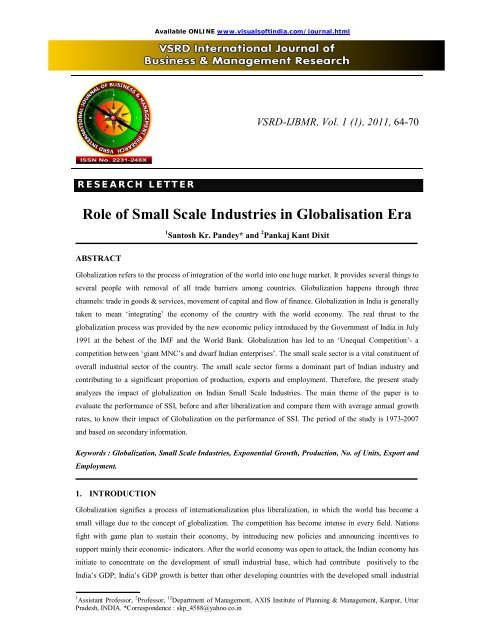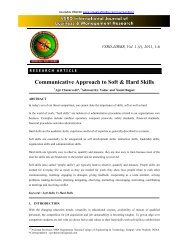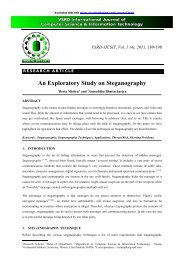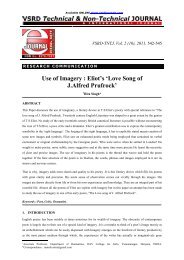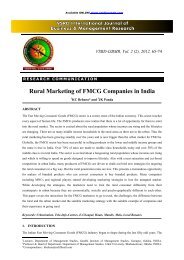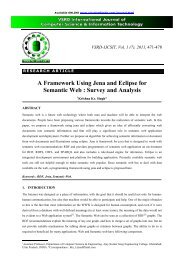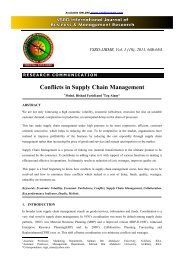Role of Small Scale Industries in Globalisation Era - vsrd ...
Role of Small Scale Industries in Globalisation Era - vsrd ...
Role of Small Scale Industries in Globalisation Era - vsrd ...
Create successful ePaper yourself
Turn your PDF publications into a flip-book with our unique Google optimized e-Paper software.
Available ONLINE www.visuals<strong>of</strong>t<strong>in</strong>dia.com/journal.html<br />
VSRD-IJBMR, Vol. 1 (1), 2011, 64-70<br />
R E S E A R C H L E T T E R<br />
<strong>Role</strong> <strong>of</strong> <strong>Small</strong> <strong>Scale</strong> <strong>Industries</strong> <strong>in</strong> <strong>Globalisation</strong> <strong>Era</strong><br />
1 Santosh Kr. Pandey* and 2 Pankaj Kant Dixit<br />
ABSTRACT<br />
Globalization refers to the process <strong>of</strong> <strong>in</strong>tegration <strong>of</strong> the world <strong>in</strong>to one huge market. It provides several th<strong>in</strong>gs to<br />
several people with removal <strong>of</strong> all trade barriers among countries. Globalization happens through three<br />
channels: trade <strong>in</strong> goods & services, movement <strong>of</strong> capital and flow <strong>of</strong> f<strong>in</strong>ance. Globalization <strong>in</strong> India is generally<br />
taken to mean ‘<strong>in</strong>tegrat<strong>in</strong>g’ the economy <strong>of</strong> the country with the world economy. The real thrust to the<br />
globalization process was provided by the new economic policy <strong>in</strong>troduced by the Government <strong>of</strong> India <strong>in</strong> July<br />
1991 at the behest <strong>of</strong> the IMF and the World Bank. Globalization has led to an ‘Unequal Competition’- a<br />
competition between ‘giant MNC’s and dwarf Indian enterprises’. The small scale sector is a vital constituent <strong>of</strong><br />
overall <strong>in</strong>dustrial sector <strong>of</strong> the country. The small scale sector forms a dom<strong>in</strong>ant part <strong>of</strong> Indian <strong>in</strong>dustry and<br />
contribut<strong>in</strong>g to a significant proportion <strong>of</strong> production, exports and employment. Therefore, the present study<br />
analyzes the impact <strong>of</strong> globalization on Indian <strong>Small</strong> <strong>Scale</strong> <strong>Industries</strong>. The ma<strong>in</strong> theme <strong>of</strong> the paper is to<br />
evaluate the performance <strong>of</strong> SSI, before and after liberalization and compare them with average annual growth<br />
rates, to know their impact <strong>of</strong> Globalization on the performance <strong>of</strong> SSI. The period <strong>of</strong> the study is 1973-2007<br />
and based on secondary <strong>in</strong>formation.<br />
Keywords : Globalization, <strong>Small</strong> <strong>Scale</strong> <strong>Industries</strong>, Exponential Growth, Production, No. <strong>of</strong> Units, Export and<br />
Employment.<br />
1. INTRODUCTION<br />
Globalization signifies a process <strong>of</strong> <strong>in</strong>ternationalization plus liberalization, <strong>in</strong> which the world has become a<br />
small village due to the concept <strong>of</strong> globalization. The competition has become <strong>in</strong>tense <strong>in</strong> every field. Nations<br />
fight with game plan to susta<strong>in</strong> their economy, by <strong>in</strong>troduc<strong>in</strong>g new policies and announc<strong>in</strong>g <strong>in</strong>centives to<br />
support ma<strong>in</strong>ly their economic- <strong>in</strong>dicators. After the world economy was open to attack, the Indian economy has<br />
<strong>in</strong>itiate to concentrate on the development <strong>of</strong> small <strong>in</strong>dustrial base, which had contribute positively to the<br />
India’s GDP; India’s GDP growth is better than other develop<strong>in</strong>g countries with the developed small <strong>in</strong>dustrial<br />
____________________________<br />
1 Assistant Pr<strong>of</strong>essor, 2 Pr<strong>of</strong>essor, 12 Department <strong>of</strong> Management, AXIS Institute <strong>of</strong> Plann<strong>in</strong>g & Management, Kanpur, Uttar<br />
Pradesh, INDIA. *Correspondence : skp_4588@yahoo.co.<strong>in</strong>
Santosh Kr. Pandey et. al / VSRD International Journal <strong>of</strong> Bus<strong>in</strong>ess & Management Research Vol. 1 (1), 2011<br />
sector.<br />
In order to impart more vitality and growth to small scale sector, a separate policy statement has been<br />
announced for small, t<strong>in</strong>y and village enterprises on 6thAugust, 1991. This policy statement was a leap-forward<br />
because it was the first time that Government had issued a separate policy statement for the small and<br />
decentralized sector. In the past, small scale sector merited only two or three paragraphs <strong>in</strong> the more general<br />
<strong>in</strong>dustrial policy statements. The fact that Government considered it necessary to make a separate policy<br />
statement for small enterprises was a welcome recognition to the dynamic and vibrant nature <strong>of</strong> the sector. This<br />
policy statement proposed some path-break<strong>in</strong>g measures to mitigate the handicaps that were faced up by small<br />
enterprises <strong>in</strong> respect. Government <strong>of</strong> India <strong>in</strong>troduced a large number <strong>of</strong> <strong>in</strong>novative promotional measures to<br />
uplift the growth <strong>of</strong> small scale sector. Major features <strong>of</strong> the <strong>Small</strong> Industrial policy <strong>of</strong> 1991:<br />
1. Emphasis to shift from cheap credit to adequate credit.<br />
2. Equity participation by other undertak<strong>in</strong>gs (both domestic and foreign) upto 24 percent.<br />
3. Introduc<strong>in</strong>g <strong>of</strong> factor<strong>in</strong>g services by banks.<br />
4. Market<strong>in</strong>g <strong>of</strong> mass consumption goods under common brand name.<br />
5. Sett<strong>in</strong>g up <strong>of</strong> sub- contract<strong>in</strong>g exchanges.<br />
6. Establishment <strong>of</strong> technology development cell.<br />
7. Open<strong>in</strong>g <strong>of</strong> quality counsell<strong>in</strong>g and technology <strong>in</strong>formation centres.<br />
8. New technology up gradation programmes.<br />
2. WHAT IS GLOBALIZATION?<br />
Globalization refers to an advanced stage <strong>of</strong> development where capital, technology, labour, raw materials,<br />
<strong>in</strong>formation and transportation, distribution and market<strong>in</strong>g are <strong>in</strong>tegrated or <strong>in</strong>terdependent on a globe scale.<br />
This gives rise to the economy that works as a unit <strong>in</strong> real time on a planetary basis (Kuper and Kuper, 1996:<br />
345-46). Thus, globalization is a "process" <strong>of</strong> <strong>in</strong>tegration with the world economy; liberalization is the "means"<br />
<strong>of</strong> such a process and growth is the "end" <strong>of</strong> both liberalization and globalization (Shrestha, 1999: 170).<br />
Globalization is not a new phenomenon. In the immediate post-World War-II period, globalization was ma<strong>in</strong>ly<br />
driven by rapid growth <strong>in</strong> foreign trade while <strong>in</strong> the 1950s and 1960s, foreign direct <strong>in</strong>vestment (FDI) started to<br />
play an <strong>in</strong>creas<strong>in</strong>gly important role <strong>in</strong> this process. Over the last three decades and based on a global trend <strong>of</strong><br />
trade and <strong>in</strong>vestment liberalization, the world economy has evolved <strong>in</strong>to a highly <strong>in</strong>tegrated system. Today,<br />
globalization <strong>in</strong>volves numerous features, but the follow<strong>in</strong>g three seem to be the ma<strong>in</strong> eng<strong>in</strong>e driv<strong>in</strong>g global<br />
economic <strong>in</strong>tegration:<br />
a) Internationalization <strong>of</strong> production accompanied by changes <strong>in</strong> the structure <strong>of</strong> production<br />
b) Expansion <strong>of</strong> <strong>in</strong>ternational trade <strong>in</strong> trade and services, and<br />
Page 65 <strong>of</strong> 70
Santosh Kr. Pandey et. al / VSRD International Journal <strong>of</strong> Bus<strong>in</strong>ess & Management Research Vol. 1 (1), 2011<br />
c) Widen<strong>in</strong>g and deepen<strong>in</strong>g <strong>of</strong> <strong>in</strong>ternational capital flows.<br />
3. FOREIGN TRADE GLOBALIZATION<br />
Foreign trade Globalization opens the economic borders <strong>of</strong> the countries and emphasizes to remove the trade<br />
barriers and curtail <strong>in</strong> import tariffs <strong>of</strong> the countries. In the context <strong>of</strong> globalization and be<strong>in</strong>g the member <strong>of</strong><br />
WTO, the member should not discrim<strong>in</strong>ate the foreign product. The countries with the comparative advantages<br />
<strong>in</strong> the products can be benefited. But, <strong>in</strong> Nepal the trade balance is worsen<strong>in</strong>g year by year. Export is shr<strong>in</strong>k<strong>in</strong>g<br />
and import has been expand<strong>in</strong>g nowadays. The trade deficit has been widened and the import/export ratio is<br />
about 3:1. The trade dependency has been significantly <strong>in</strong>creas<strong>in</strong>g with India compris<strong>in</strong>g 61 percent <strong>of</strong> total<br />
volume <strong>of</strong> trade <strong>in</strong> fiscal year 2008/09 (Economic Survey, 2009/10).<br />
4. PRIVATIZATION AND INDUSTRIAL GROWTH<br />
Globalization always favors private sectors. Privatization and less role <strong>of</strong> state <strong>in</strong> bus<strong>in</strong>ess activities can <strong>in</strong>crease<br />
the quality and work<strong>in</strong>g efficiency. It reduces the government burden on unnecessary economic activities and<br />
budget deficit. In Nepal, Privatization Act, 1993 has been <strong>in</strong>troduced and 27 public enterprises have been<br />
privatized till the date. But, most <strong>of</strong> the privatized enterprises have not run efficiently, some have already been<br />
closed down. The process has somehow become irrational <strong>in</strong> Nepal. Globalization and liberalization <strong>in</strong> the<br />
<strong>in</strong>dustrial sector has negligible impact on <strong>in</strong>dustrial growth <strong>in</strong> Nepal. Manufactur<strong>in</strong>g sector only contributes 7-8<br />
percent <strong>in</strong> GDP. In general, the private sector <strong>in</strong> Nepal has a trade-oriented character rather than an <strong>in</strong>dustrial<br />
character and hence it is reluctant to bear high risks. It seeks to harvest larger pr<strong>of</strong>its from a short period<br />
<strong>in</strong>vestment, <strong>of</strong>ten through small amount <strong>of</strong> share capital and big volume <strong>of</strong> <strong>in</strong>stitutional loans. Secondly, the<br />
private sector is <strong>in</strong> the form <strong>of</strong> family groups that has recently taken a shape <strong>of</strong> 'Bus<strong>in</strong>ess Houses'.<br />
5. PERFORMANCE OF SMALL SCALE INDUSTRIES IN THE GLOBALIZATION ERA<br />
SSI is considered as the backbone <strong>of</strong> the private sector all over the world, which assures their role <strong>in</strong> production,<br />
employment and sales. In addition to their role <strong>in</strong> economic development they play a vital role <strong>in</strong> social,<br />
political, and cultural development as well. However, the notable spread <strong>of</strong> SSI contributed to the <strong>in</strong>creased<br />
severity <strong>of</strong> competition between these <strong>in</strong>dustries that <strong>of</strong>ten leads to the failure <strong>of</strong> these <strong>in</strong>dustries. Most SSI fail<br />
dur<strong>in</strong>g the first year <strong>of</strong> establishment, and 90% <strong>of</strong> these <strong>in</strong>dustries are subject to failure dur<strong>in</strong>g a period not<br />
exceed<strong>in</strong>g their first 5 years. On the other side, the Mexican experience illustrates <strong>of</strong> the 200,000 small projects<br />
enter<strong>in</strong>g the market annually, no more than 70,000 projects cont<strong>in</strong>ue <strong>in</strong> the market by the second year<br />
(Bencivenga, V. Bruce, S. and Starr,R. 1995). The relative importance <strong>of</strong> the SSIs <strong>in</strong> Jordan (1990-2006)<br />
Year No. <strong>of</strong> SSIs No. <strong>of</strong> All <strong>Industries</strong> Relative Importance<br />
1990 52496 58984 89%<br />
1991 54696 61388 89%<br />
1992 64752 74369 87%<br />
Page 66 <strong>of</strong> 70
Santosh Kr. Pandey et. al / VSRD International Journal <strong>of</strong> Bus<strong>in</strong>ess & Management Research Vol. 1 (1), 2011<br />
1993 66160 75920 87%<br />
1994 66100 80363 81%<br />
1995 74896 91520 82%<br />
1996 76468 93432 82%<br />
1997 78580 95856 82%<br />
1998 81856 98768 83%<br />
1999 92923 109532 84%<br />
2000 106730 118271 90%<br />
2001 103753 115820 89%<br />
2002 105662 118492 89%<br />
2003 130149 140338 92%<br />
2004 126196 141944 88%<br />
2005 132166 145699 90%<br />
2006 135732 150222 90%<br />
Source: Department <strong>of</strong> Statistics, Yearly Statistical Bullet<strong>in</strong>s, Various Issues.<br />
As shown <strong>in</strong> table the number <strong>of</strong> the SSI <strong>in</strong>creased from 52496 projects <strong>in</strong> 1990 to 135732 projects <strong>in</strong> 2006.<br />
These numbers illustrates the relative importance <strong>of</strong> the number <strong>of</strong> SSI <strong>of</strong> the total number <strong>of</strong> <strong>in</strong>dustries <strong>in</strong><br />
Jordan is more than 80%. The SSI was distributed <strong>in</strong> Jordan <strong>in</strong>to three districts as follows (Department <strong>of</strong><br />
Statistics 2005):<br />
The northern district: 22% <strong>of</strong> the total small scale <strong>in</strong>dustries <strong>in</strong> Jordan.<br />
The middle district: 68% <strong>of</strong> the total small scale <strong>in</strong>dustries <strong>in</strong> Jordan.<br />
The southern district: 10% <strong>of</strong> the total small scale <strong>in</strong>dustries <strong>in</strong> Jordan.<br />
Furthermore, discrepancy <strong>in</strong> the relative importance <strong>of</strong> the spread <strong>of</strong> the SSI <strong>in</strong> the districts can be attributed to<br />
many factors. The most important factor is the demographic distribution that characterizes Jordan's districts, as<br />
well as to the nature <strong>of</strong> the concentration <strong>of</strong> the economic activities <strong>in</strong> these districts. However, the geographic<br />
distribution <strong>of</strong> the spread <strong>of</strong> the SSI may not relate to other economic <strong>in</strong>dicators, but it is possible to accept it as<br />
an <strong>in</strong>dicator to express the strength <strong>of</strong> most <strong>of</strong> these <strong>in</strong>dicators <strong>in</strong> favor <strong>of</strong> the middle district. On the other hand,<br />
Page 67 <strong>of</strong> 70
Santosh Kr. Pandey et. al / VSRD International Journal <strong>of</strong> Bus<strong>in</strong>ess & Management Research Vol. 1 (1), 2011<br />
the lack <strong>of</strong> data and <strong>in</strong>formation about the geographic distribution <strong>of</strong> all the economic and social <strong>in</strong>dicators<br />
concern<strong>in</strong>g the SSI – such as <strong>in</strong>vestment , employment , production , sales …..etc. - led to mak<strong>in</strong>g the analysis<br />
<strong>in</strong>clusive for all <strong>of</strong> Jordan without deal<strong>in</strong>g with details at the district level.<br />
6. CONCLUSION<br />
The f<strong>in</strong>d<strong>in</strong>gs <strong>of</strong> this study revealed:<br />
1- Generally, the SSI plays an important role <strong>in</strong> achiev<strong>in</strong>g social and economic development. The average<br />
<strong>in</strong>vested capital <strong>in</strong> these <strong>in</strong>dustries reached 4.8% <strong>of</strong> the total <strong>in</strong>vested capital <strong>in</strong> all <strong>in</strong>dustries, dur<strong>in</strong>g the period<br />
1990-2006. Also, the SSI provided 22% <strong>of</strong> the total job opportunities and contributed <strong>in</strong> achiev<strong>in</strong>g nearly 8.5%<br />
<strong>of</strong> the total value added. Lastly, their share <strong>of</strong> the total sales <strong>in</strong> the <strong>in</strong>dustrial sector was 4.8%, and most <strong>of</strong> the<br />
sales were <strong>in</strong> the domestic market.<br />
2- Despite the positive effects <strong>of</strong> the SSI <strong>in</strong> the Jordanian economy, the SSI still suffer from many weaknesses<br />
such as low average employment <strong>of</strong> women which is due to the socioculture. The percentage <strong>of</strong> women work<strong>in</strong>g<br />
<strong>in</strong> the SSI was only 1.7%. Also, the percentage <strong>of</strong> foreign labor <strong>in</strong> the SSI is relatively high.<br />
3- The f<strong>in</strong>ancial <strong>in</strong>stitutions are characterized by their wide spread. There are 17 banks provid<strong>in</strong>g f<strong>in</strong>ance for this<br />
category <strong>of</strong> <strong>in</strong>dustry and more than 24 programs have been accredited. Some programs are oriented towards a<br />
specific age category such as youths, and some <strong>in</strong>stitutional activities are exclusively for specific district or<br />
specific geographic regions.<br />
4- There is an <strong>in</strong>crease <strong>in</strong> the productivity <strong>of</strong> labor <strong>in</strong> the SSI, which <strong>in</strong>dicates that the tra<strong>in</strong><strong>in</strong>g programs directed<br />
towards these <strong>in</strong>dustries have <strong>in</strong>creased.<br />
5- Increas<strong>in</strong>g the <strong>in</strong>vestment <strong>in</strong> SSI by 1% lead to an <strong>in</strong>crease <strong>of</strong> the value added by 0.78%, production growth<br />
by 0.81%, and employment by 0.67%.<br />
6- All the results <strong>of</strong> the statistical analysis <strong>of</strong> the SSI were statistically acceptable and no differences were<br />
noticed between the effect <strong>of</strong> SSI and other <strong>in</strong>dustries on the economic development <strong>of</strong> the Jordanian economy.<br />
7- Market<strong>in</strong>g has been identified as one <strong>of</strong> the major problem areas <strong>of</strong> the small scale<strong>in</strong>dustries and it has been<br />
ranked as the second most important reason for the closure <strong>of</strong>small scale bus<strong>in</strong>esses. Accord<strong>in</strong>gly, small firms<br />
will not be able to penetrate markets, national or <strong>in</strong>ternational, even if market<strong>in</strong>g support is given by government<br />
agencies.<br />
7. RECOMMENDATIONS<br />
Based on this study's analysis and results, the follow<strong>in</strong>g recommendations may contribute to <strong>in</strong>creas<strong>in</strong>g the role<br />
<strong>of</strong> development <strong>of</strong> SSI <strong>in</strong> the Jordanian economy.<br />
1- Establish<strong>in</strong>g government centers <strong>in</strong> all districts <strong>in</strong> Jordan to provide the needed services and facilities to SSI<br />
<strong>in</strong> order to <strong>in</strong>crease their role <strong>in</strong> the economic development <strong>of</strong> the Jordanian economy.<br />
Page 68 <strong>of</strong> 70
Santosh Kr. Pandey et. al / VSRD International Journal <strong>of</strong> Bus<strong>in</strong>ess & Management Research Vol. 1 (1), 2011<br />
2- Establish<strong>in</strong>g specialized tra<strong>in</strong><strong>in</strong>g centers for SSI to provide special tra<strong>in</strong><strong>in</strong>g programs on how to establish a<br />
project and how to ma<strong>in</strong>ta<strong>in</strong> the cont<strong>in</strong>uity <strong>of</strong> that project.<br />
3- Foster<strong>in</strong>g technology development through either technology transfer or technological <strong>in</strong>novations or <strong>in</strong>terfirm<br />
l<strong>in</strong>kages should be emphasized <strong>in</strong> the light <strong>of</strong> dimensions <strong>of</strong> global competition and its negative fall out as<br />
well as positive opportunities, to SSIs entrepreneurs through sem<strong>in</strong>ars and workshops, at the local level.<br />
4- The f<strong>in</strong>ancial <strong>in</strong>frastructure is needs, and an adequate <strong>in</strong>flow <strong>of</strong> credit to the sector should be ensured, tak<strong>in</strong>g<br />
<strong>in</strong>to consideration the grow<strong>in</strong>g <strong>in</strong>vestment demands <strong>in</strong>clud<strong>in</strong>g the requirements <strong>of</strong> technological transformation.<br />
5- Limit<strong>in</strong>g the establishment <strong>of</strong> small scale <strong>in</strong>dustries to designated <strong>in</strong>dustrial areas for better monitor<strong>in</strong>g and<br />
periodic surveys, enabl<strong>in</strong>g the M<strong>in</strong>istry <strong>of</strong> Industry to make policy corrections from time to time<br />
6- Establish<strong>in</strong>g strong relations between small and large firms. One <strong>of</strong> the major objectives <strong>of</strong> this scheme<br />
would be to provide reliable <strong>in</strong>formation by large-scale <strong>in</strong>dustries to the smallscale <strong>in</strong>dustries about new<br />
methods <strong>of</strong> market<strong>in</strong>g and how to participate <strong>in</strong> the <strong>in</strong>ternational market.<br />
7- Increas<strong>in</strong>g exports <strong>of</strong> small- scale <strong>in</strong>dustries with governmental aid by exhibit<strong>in</strong>g their productions <strong>in</strong><br />
International Exhibitions.<br />
8- To reap the benefits <strong>of</strong> SSI, Jordanian policy and decision makers have to enact and enforce the employment<br />
<strong>of</strong> Jordanian workers <strong>in</strong> the SSI.<br />
9- It is highly recommended that Jordanian policy and decision makers to work <strong>in</strong> cooperation with other<br />
<strong>in</strong>terest groups to tra<strong>in</strong> and encourage SSI to employ more Jordanians women. It is obvious that a large portion<br />
<strong>of</strong> unemployed <strong>in</strong> Jordan is among women.<br />
8. REFERENCES<br />
[1] Smith, A. (1998), Tra<strong>in</strong><strong>in</strong>g and Development <strong>in</strong> Australia. 2nd ed. 261. Sydney: Butterworths.<br />
[2] Richard Arvid Johnson. Management, systems, and society : an <strong>in</strong>troduction. Pacific Palisades, Calif.:<br />
Goodyear Pub. Co..<br />
[3] Richard Beckhard (1969). Organization development: strategies and models. Read<strong>in</strong>g, Mass.: Addison-<br />
Wesley. pp. 114. I<br />
[4] Wendell L French; Cecil Bell. Organization development: behavioral science <strong>in</strong>terventions for organization<br />
improvement. Englewood Cliffs, N.J.: Prentice-Hall.<br />
[5] Weisbord, Marv<strong>in</strong>. (1987). Productive Workplace: Organiz<strong>in</strong>g and manag<strong>in</strong>g for dignity, mean<strong>in</strong>g and<br />
community. Jossey-Bass Publishers, San Francisco.<br />
[6] Richard Arvid Johnson (1976). Management, systems, and society : an <strong>in</strong>troduction. Pacific Palisades,<br />
Calif.: Goodyear Pub. Co.. pp.<br />
[7] Bradford, D.L. & Burke, W.W. eds, (2005). Organization Development. San Francisco: Pfeiffer.<br />
[8] Bradford, D.L. & Burke, W.W.(eds), 2005, Re<strong>in</strong>vent<strong>in</strong>g Organization Development. San Francisco:<br />
Pfeiffer.<br />
[9] deKler, M. (2007). Heal<strong>in</strong>g emotional trauma <strong>in</strong> organizations: An O.D. Framework and case study.<br />
Page 69 <strong>of</strong> 70
Santosh Kr. Pandey et. al / VSRD International Journal <strong>of</strong> Bus<strong>in</strong>ess & Management Research Vol. 1 (1), 2011<br />
Organizational Development Journal<br />
[10] Kurt Lew<strong>in</strong> (1958). Group Decision and Social Change. New York: Holt, R<strong>in</strong>ehart and W<strong>in</strong>ston.<br />
[11] Richard Arvid Johnson (1976). Management, systems, and society: an <strong>in</strong>troduction. Pacific Palisades,<br />
Calif.: Goodyear Pub. Co..<br />
[12] Wendell L French; Cecil Bell (1973). Organization development: behavioral science <strong>in</strong>terventions for<br />
organization improvement. Englewood Cliffs, N.J.: Prentice-Hall.<br />
<br />
Page 70 <strong>of</strong> 70


